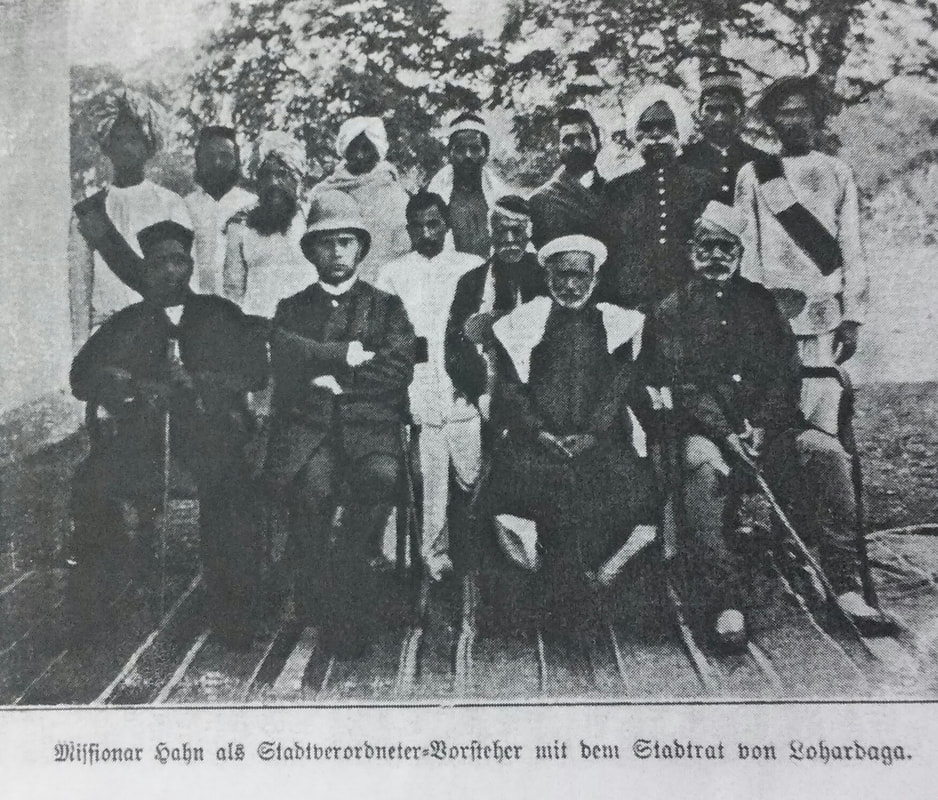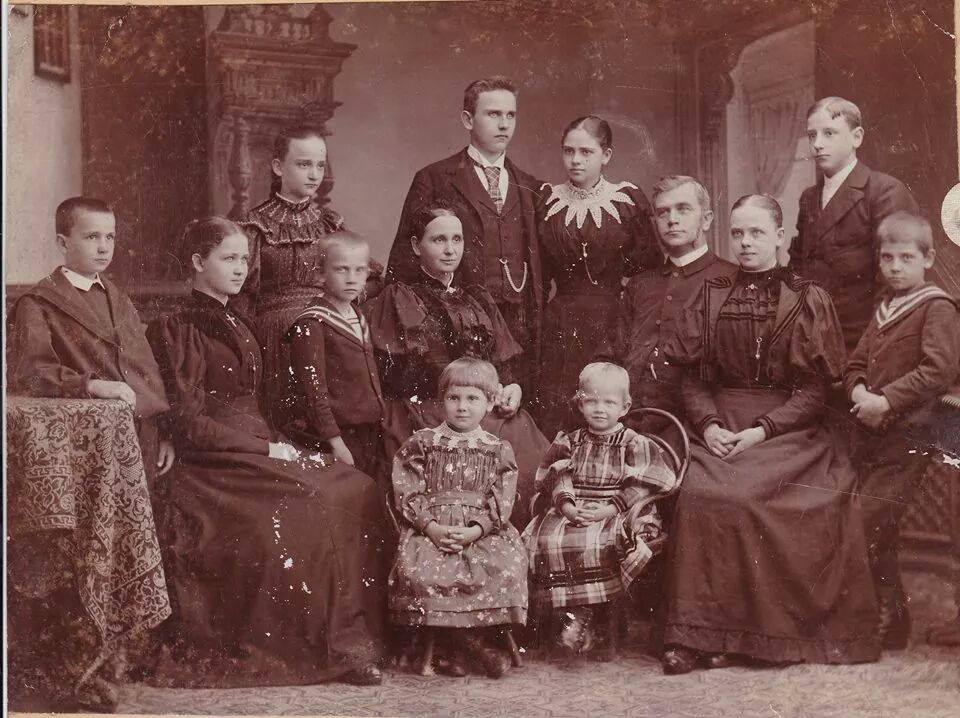|
*Book of Remembrance:
A German Missionary among the Adivasi of East India* This biography of a German missionary in British India prior to the World Wars may well join the ranks of exotic tales of Christian missionaries or the British Raj. It is more than a missionary story. It is also a story of the Adivasi (India’s indigenous people) and their search for liberation and autonomy, well before India’s Independence. The narrative is inspired by an Old Testament prophetic call to write a Book of Remembrance (Malachi 3:16). to restore the collective memory of a people. My great-great grandfather, FERDINAND HAHN, was forgotten among his German-American descendants. Launching on a journey to understand our family's immigrant story to the United States from Germany led to a unique discovery. In 1868,unlike millions of other Germans who migrated to America, Ferdinand migrated to India. All his children were born in India, as British subjects. Of the ten living adults, half of them eventually settled in the United States. After a century of migration, wars, and other hardship, this book brings to rememberance the first generation that connected our family to India. By the end of his life in India, Ferdinand was given the Kaiser-I-Hind gold metal, the highest civilian honor issued by the British Viceroy of India. But what is more significant is that he is still remembered today for the legacy he left to the Adivasi people of Chota Nagpur in eastern India. Here he is remembered for his efforts to preserve a tribal language and his endearing work among the marginalized and oppressed. He played a significant role in establishing one of the strongest and oldest Adivasi Christian communities that now has 800,000 members. As they continue to piece together their own history, I was encouraged to write his story. In remembering him, their story will also be told. Missionary stories are usually told from a purely Christian perspective. I believe modern Christians can learn much from this 19th century missionary. However, in writing this I was also influenced by academia to explore the social impact of missionaries and what shapes identity. Rather than a Christian apologetic or academic analysis, my style of writing takes more of a literary story-telling tone. I offer a personal interpretation of Ferdinand’s inner life, family dynamics and cross-cultural relationships. To add to the authenticity, I fold in translated excerpts from the wealth of primary documents written by Ferdinand or his contemporaries. Because I am interested in how German, Indian, British and American cultures shaped me, I explore what elements shaped Ferdinand. The story covers the scope of Ferdinand’s life, starting with his early desire to escape the confines of his parochial village. He would never escape the impact Germany would have on his life: from his early fascination with seventeenth and eighteenth centuries German missionaries and scholars of Orientalism, to the unified Germany of 1871 and its ongoing changes in religion, government, and culture. The unique mission agency in Berlin that employed him, granted him opportunities that would normally not have been available to a shoemaker. His family and fellow missionaries kept him anchored to his German culture. However, unlike those who lauded their nationalism over others, he had a remarkable deep and sincere appreciation for the Adivasi. Because he understood that language, region, experience and history shaped his identity, he was able to appreciate those elements in the “other”. Early in my writing, a friend asked me to write about what Ferdinand learned from the Adivasi, not only what he did for them. In learning their languages, Ferdinand adapted new ways of communicating, which can be seen in how he adapted his preaching to be more interactive, telling stories and incorporating congregational question and answer. The primary literature for my research praised the remarkable contributions of the missionaries. However, I could read in Ferdinand’s writings a recognition of the symbiotic relationship between missionary and Adivasi. Missionaries may have brought the message of Christ to the Adivasi, but the Adivasi were the primary actors in establishing Christianity in Chota Nagpur. In nany ways their culture was more compatible to Christianity and their faithful zeal mire sincere than that of many Europeans. Western Christians had often been divisive, while the strength and unity of community among the Adivasi was something to be admired. If we were to summarise Ferdinand’s life work it was to build community. He worked closely with Adivasi leaders in running churches, schools, hospitals, and other social services, all to strengthen the community, believing fourishing communities could withstand all winds of change. And the world was ever-changing. He was also instrumental in establishing three self-sustaining communities for India's most marginalized, those suffering from Hansen’s Disease (leprosy). The prevailing concern for every Adivasi was the systematic oppression that they endured. It is a struggle that persists even today. Since the 17th century outsiders flowed into the jungle region, turning the communal ancestral land of the original dwellers into private property and introducing a money economy. The Adivasi who had been left unmolested for centuries were now suppressed by the landlords, labor contractors and tax collectors. Whenever the Adivasi rebelled, they were repressed by the forces of the British East India company that had stretched its dominance even into this remote jungle region. When the British Crown took over after 1857 they imposed law, order and administrative structure. In general, they only reinforced the standing social order and had little understanding of the Adivasi plight. But the German missionaries since 1845 had given them education that began to equip them to learn how to navigate in this new colonial world that extended far beyond the jungles. It is also relevant to understand the role Ferdinand played in creating an autonomous Adivasi Christian community. By the time of his death in 1910, a new generation of German missionaries were coming to India to work and with them new colonialist and nationalist sentiments. They assumied Germans would be in India for a long time and the emphasis on making the Adivasi self-reliant began to be watered down. There were Germans, who like the British colonizers, doubted that these poor people could ever stand on their own, they were convinced that they would always need European support. It almost seems providential that the senior missionaries were systematically removed, through illness or death, until the final blow came with the outbreak of World War I. Suddenly all German residents of British India were declared “enemies of the state,” interned in concentration camps, and returned to Germany. With the expulsion of their missionaries the Adivasi did stand on their own. In 1919 they were the first native church in pre-independent India to be granted autonomy from Western administration. My hope is that this Book of Remembrance will add to the commemoration of the Gossner Evangelical Lutheran Church of Chotanagpur and Assam as it celebrates their centennial next year. Throughout the narrative I have braided in family stories that may begin to explain why this ancestor, who left such a rich legacy, was forgotten by his own descendants. As he devoted his life to the Adivasi, within the context of his family his internal struggles and flaws were more apparent. His wife, Doris, was an unsung partner in ministry. Their thirteen children, all born in India, were sent to Germany for education at the age of seven. Such separation produces untold consequences. Among them, the oral stories that are passed down from generation to generation were suppressed. The Adivasi rely on oral traditions to keep their culture alive. Ferdinand wrote down many stories that he learned, primarily for outsiders to understand. Now the Adivasi are starting to write down their own stories to preserve and celebrate their culture. Likewise, I have found an unmeasurable treasure in remembering this lost story, of my great-great grandfather, Ferdinand Hahn. ------ * since this post I have decided to change the title to: Among the Original Dwellers: Remembering Ferdinand Hahn
1 Comment
|
2016 -2020These musings include the journey of my writing on the history of my great great grandparents and the travels for research to India, Germany and other places of interest. Archives
June 2020
Categories |


 RSS Feed
RSS Feed